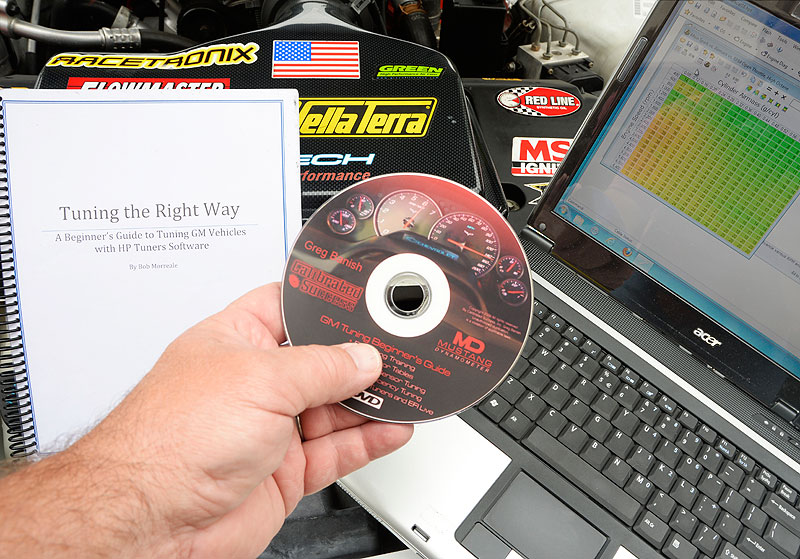Tuning or, more properly, “calibrating” the ECMs of late model Corvettes is misunderstood by some DIY Corvette enthusiasts.
It’s surprising the amount of “tuners” who concentrate only on the calibration’s wide-open throttle fuel and spark, give little attention to part throttle driveability and make foolish mistakes advocated by forums posts and social media discussions such as:
––copying the high-octane spark data into the low octane spark table
––zeroing data in the IAT or ECT Spark tables
––desensitizing knock sensors to solve problems with false knock or other knock sensor or electronic spark control (ESC) issue rather than diagnosing the ESC problem and repairing it.
––calibrating overly aggressive spark tables for the gasoline available and the climate.
––failing to recalibrate the main VE table for engines with valve train mods which change valve lift or duration.
––failing to recalibrate MAF tables for engines with aftermarket MAF sensors, aftermarket intake kits, aftermarket air ducts or aftermarket throttle bodies.
Then, these people wonder why the cars make power on the chassis dyno but sometimes drive poorly, suffer significant knock retard on pump gas on a hot day and idle like crap.
Trust me, the folks who really know calibration didn’t come out of the womb with a wide-band in one hand and a disc of programming software in the other nor did they hang out a “Tuner” sign after spending two weeks worth of evenings on forum sites. They had to learn the calibrating craft the hard way, in class then gaining experience. The guys at OEs have four-year college degrees in engine controls calibration. Others in the aftermarket, such as Calibrated Success’ Greg Banish, were former car company calibration engineers, who later moved to the aftermarket and finally, in Banish’s case, into to education.
Up until the two years ago, while I had diagnosed and serviced cars with computers, I never learned calibration. I was up for a challenge, so I acquired HPTuners’ ‘VCM Suite’ from Summit Racing. For a review of that click here. You can learn tuning several ways. Do an “internship” with an experienced tuner–fabulous idea, but a rare opportunity. Internet forums–reasonable in theory, but in practice, be cautious when reading calibration discussions because there are forum members who know enough to be dangerous and are quick to bloviate about tuning. Not to say experienced calibrators aren’t on-line–it’s just they’re harder to find. Learn by trial-and-error–bad idea. You can read books, watch DVDs or take classes. I opted for that. First, I read: Jeff Hartman’s, How to Tune and Modify Automotive Engine Management Systems, published by Motorbooks, Greg Banish’s Designing and Tuning High-Performance Fuel Injection Systems and Engine Management: Advanced Tuning along with Harold Bettes’ and Bill Hancock’s Dyno Testing and Tuning, all three published by CarTech.
My next step was a home-study course: A Beginner’s Guide to Tuning GM Vehicles with HP Tuners Software, offered by the Tuning School of Odessa, Florida. Finally, I watched GM Beginner’s Tuning Guide, a DVD by Greg Banish’s “Calibrated Success” and sold by Summit Racing.
The home-study book had a few confusing statements and some lax proofreading. The DVD’s videography and editing were substandard in spots. Nevertheless, the training offered by these two instructional media was quite beneficial for me, who was learning to properly calibrate the ECM in a 1997-2013 Corvette. The two training aids cover some of the same ground but also, differ in some of their content. The Tuning School’s books focus mainly on road testing for data logging whereas, Calibrated Success’ DVDs advocate only use of a chassis dyno for testing and data logging. I took some of my testing philosophy from each.
In some cases, particularly in learning to calibrate the Main VE and MAF tables, I found the Calibrated Success beginner’s DVD to be a better choice, however, when it came to figuring out what specific calibration tasks would be done with road tests, the Tuning School’s two books in its basic class, A Beginner’s Guide to Tuning GM Vehicles with HP Tuners Software and MAF and VE Tuning were very useful.
For the DIY who has never done any reprogramming, wants to start with HPTuners and either lacks access or is not readily to spend a lot of money on dyno time, the instructional media with which to begin is the Tuning School’s books but, once you get into more advanced calibration tasks, such as having to rewrite a Main VE Table, the DVDs from Calibrated Success are a better choice, but, either way–the Tuning School home-study books or Calibrated Success DVD–you’re better off with some instruction created by professionals than trying to learn calibration from forum web sites or by trial-and-error. Finally, both the Tuning School and Calibrated Success offer classroom instruction. If you can afford it, such training is even better. See their web sites for more information.
The next part of some training that’s on my list is the Tuning School’s An Advanced Guide to Tuning GM Vehicles with HPTuners Software and Calibrated Success’ GM Tuning Advanced Guide.
For more information contact:

